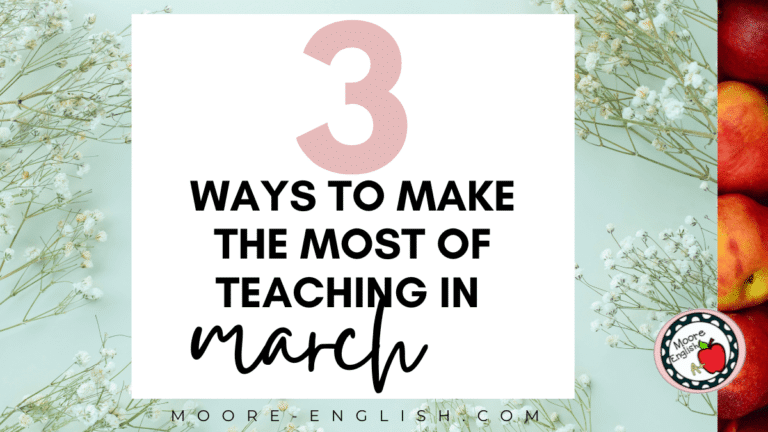When we’re reading, we want dynamic characters. We want characters to grow, evolve, and improve because we want to believe that we are also capable of becoming better people. For the English classroom, dynamic characters become vivid examples for our students. A well-developed character who grows can also become a tool for teaching theme.
With all this in mind, I wanted to share these 11 dynamic characters that will strengthen your English class!
This post this post may contain affiliate links. Please read the Terms of Use.
Classic Dynamic Characters
For me, some of the most memorable dynamic characters unfold slowly over the course of a novel or drama. This gives readers plenty of time to know the characters, to see them at their best and their worst, to see their strengths and limitations, and to see how they are challenged and rewarded.
First, Scout Finch from To Kill a Mockingbird by Harper Lee is the quintessential dynamic character. Scout, her brother Jem, and her friend Dill grow consistently. At every opportunity, Harper Lee gives Scout a chance to grow. Even seemingly insignificant conversations about roly-polys, Egyptians, and Hitler offer Scout a chance to think critically about her world. Grab all my favorite To Kill a Mockingbird resources.
Like Scout Finch, Elizabeth Bennet and Fitzwilliam Darcy learn a great deal about the dangers of prejudice. Unlike Scout, Elizabeth and Darcy are adults, and their growth is associated largely with classism and feminism. In Pride and Prejudice by Jane Austen, a clever satire sets the scene for two characters to grow and change in a world that is disinterested in change. My favorite Pride and Prejudice resources are all in this bundle.
Where Scout and Elizabeth end their stories happily, John Proctor is a dynamic character who does not. In The Crucible by Arthur Miller, Proctor does grow and change in positive ways. He accepts the consequences of his actions and realizes that integrity is more valuable than reputation. Ultimately, his changed behavior leads to tragedy (and to a complete allegory), but that conclusion is satisfying in its own way. All of my resources for teaching The Crucible are here.
Like John Proctor, the Ancient Mariner is a dynamic character who has his own kind of tragedy. In “The Rime of the Ancient Mariner,” Samuel T. Coleridge captures the dangers of hubris. The Ancient Mariner’s “curse” also emphasizes the importance of learning from others’ mistakes and of continually speaking truth to human error. While this is a poem, it’s so long that I plan several days for teaching this one. I also prefer to use this version of the text, which has rich text features and includes all the glosses.
Dynamic Characters in Short Works
As teachers, we know that there is never enough time to teach everything we’d like. While a novel or a play is an ideal place to encounter dynamic characters, sometimes we need shorter works to teach similar skills.
First, “Names” by Teresa Mei Chuc describes the speaker’s journey to accepting who they are. While the speaker’s journey and growth is unique, their struggle with identity is something that all students find relatable. Read it here.
Similarly, “When I Was One-and-Twenty” by A. E. Housman deals with aging. While the last lines are a little more on the playful side (at least for someone reading from an age greater than twenty-two), the concepts in the poem still relate to students. Read it here.
Like Housman’s speaker, the speaker in “Those Winter Sundays” by Robert Hayden is young. However, the speaker’s realization is not about his identity but about his understanding of his father. The speaker’s realization resonates because it takes some perspective to see how much our loved ones care or how their small actions can be their greatest demonstrations of affection. The past tense in this poem does a good job capturing the speaker’s dynamic characterization. Read it here.
While the other poems on this list show dynamic characters through reflection, “Dothead” by Amit Majumdar captures growth in the moment. The setting in “Dothead” is the relatable crucible of the school cafeteria. The character’s growth is what readers want for every character but what so few characters (and people) have the strength to capture. Read it here.
Two Exceptions
Of course, there’s an exception to every rule. While we want dynamic characters to grow and change in positive ways, sometimes dynamic characters get worse.
First, the speaker in “The Yellow Wall-paper” by Charlotte Perkins Gilman certainly changes. Unfortunately, the changes in her character are not all in the spirit of positive growth or mental health. Of course, the patriarchy is responsible for those changes, but they are negative nevertheless. Read it here.
Similarly, “A White Heron” by Sarah Orne Jewett captures changes in Sophie. Like Scout, Sophie is young and naive, perhaps even more so than Scout. However, Sophie’s growth is more like Dill’s in that her encounter with the hunter ruins her innocence. While Scout learns important lessons about justice and prejudice, Sophie learns about commodification and objectification. Read her story here.











